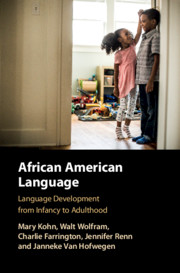Book contents
- African American Language
- African American Language
- Copyright page
- Contents
- Figures
- Tables
- Preface
- Abbreviations
- 1 Coming of Age in African American Language
- 2 The Analysis of Sociolinguistic Change over the Lifespan
- 3 Profiles of Change
- 4 Vowel Variation across Time and Space
- 5 Caretaker’s Influence on Vernacularity
- 6 The Influence of Peers on the Use of African American Language
- 7 Stylistic Variation in the Early AAL Lifespan
- 8 The Relationship of African American Language and Early Literacy Skills
- 9 A Longitudinal Study in Retrospect
- Appendix AAL Feature Code Key
- Index
- References
9 - A Longitudinal Study in Retrospect
Published online by Cambridge University Press: 24 November 2020
- African American Language
- African American Language
- Copyright page
- Contents
- Figures
- Tables
- Preface
- Abbreviations
- 1 Coming of Age in African American Language
- 2 The Analysis of Sociolinguistic Change over the Lifespan
- 3 Profiles of Change
- 4 Vowel Variation across Time and Space
- 5 Caretaker’s Influence on Vernacularity
- 6 The Influence of Peers on the Use of African American Language
- 7 Stylistic Variation in the Early AAL Lifespan
- 8 The Relationship of African American Language and Early Literacy Skills
- 9 A Longitudinal Study in Retrospect
- Appendix AAL Feature Code Key
- Index
- References
Summary
The monumental research project reported here emerges at a crucial juncture in the field, bridging work on individual variation across distinct life stages with more traditional questions related to community variation, style, and change. The project expands previous approaches to African American Language (AAL) by considering the interaction between life stages, a host of social variables, and language use. The participants come from a wide variety of neighborhoods and communities, allowing us to move beyond the tradition of prioritizing highly vernacular speakers from ethnically homogenous communities to investigate the relationship between segregation and language variation. The depth and breadth of this study adds a new richness to our understanding of AAL as it relates to distinct life stages and social contexts. It also represents a more inclusive and comprehensive variationist perspective by adding to the analytical toolkit the composite dialect index that has traditionally been eschewed and dismissed by variationists in favor of myopically focused isolated, single linguistic structures. Though this methodological inclusion is controversial in variationist studies, we have offered empirical evidence and argued for its methodological utility and its theoretical validity as a complement to traditional variation studies.
Keywords
- Type
- Chapter
- Information
- African American LanguageLanguage development from Infancy to Adulthood, pp. 208 - 226Publisher: Cambridge University PressPrint publication year: 2020

